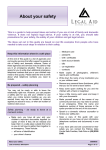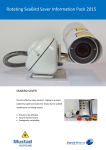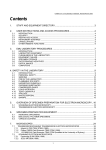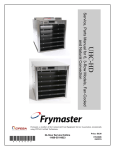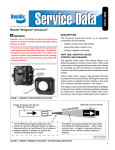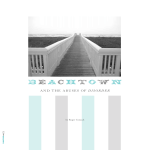Download Full Article - Notornis and Birds New Zealand
Transcript
Notornis, 2007, Vol. 54: 121-136 0029-4470 © The Ornithological Society of New Zealand, Inc. 121 Validating locations from CLS:Argos satellite telemetry D.G. NICHOLLS 31 Northcote Road, Armadale, Victoria 3143, Australia C.J.R.ROBERTSON* P.O. Box 12397, Wellington 6144, New Zealand [email protected] Abstract Satellite tracking, with the CLS:Argos system, has provided enormous benefits to wildlife studies, especially for oceanic bird species. The system provides 2 locations, (1 from each side of the satellite orbit), but they are irregular over time and of variable accuracy. Procedures are described here to identify outlier locations and retain the maximum number of valid observations from DIAG files, thus producing a more homogeneous data set from which to map distributions, track movements, and investigate behaviour, while determining the rate and direction of travel. Nicholls, D.G; Robertson, C.J.R. 2007. Validating locations from CLS:Argos satellite telemetry. Notornis 54(3): 121-136. Keywords Argos; telemetry; animal tracking; oceanic birds; flight speed; albatross;shearwater; bird distribution INTRODUCTION Satellite tracking, using the CLS:Argos system, has provided enormous benefits to wildlife studies, especially for oceanic bird species. The system links a location and data collection receiver aboard NOAA satellites and miniature low-powered transmitters (platform transmitter terminals [PTT]) attached to wild animals. It uses the Doppler effect, i.e. the change of a PTT’s radio frequency, to determine the location. The satellites are in polar orbit, each passing overhead every c.3 h, and up to 4 satellites are available to locate any PTT-tagged animal. The satellite orbits are not equally spaced relative to each another and so the resulting locations are not spaced regularly throughout the day. The frequency of reported locations is highest at high latitudes and decreases with latitudes approaching the Equator. Up to 20 location records, of variable positional accuracy (Anon. 1999; CLS:Argos FAQ) day-1 can be obtained from a tracked animal. The challenge for the researcher is to retain the maximum number of observations, after using explicit and objective criteria to eliminate outliers points, to produce a homogeneous data set from which to map the animal’s distribution, trace movements or investigate behaviour, and to determine the rate of travel. CLS:Argos grades the location records according to 3 criteria, according to the CLS:Argos (Argos) assessment of the animal being tracked (e.g., Received 2 Aug 2006; accepted 31 March 2007 *Corresponding author speed of movement) (Anon. 1999): (a) Location Class (LC) indicates accuracy (LC =3, 2, 1 have an accuracy of <1 km, LC =0 > 1 km, and A, B, Z each have an unspecified accuracy; (b) Quality Index (IQ) has 2 components, based on frequency and signal stability, number and timing of the received signals, that summarise the variables affecting the Argos location calculation (highest values indicate better transmitter performance); (c) Plausibility Tests Passed (NOPC) grades the reliability of the record using tests for residual error, transmission frequency continuity, movement of the transmitter, and plausible velocity from previous position (Anon. 1999)(4 tests passed best, <2 invalid). The CLS:Argos system, provides a variety of data file formats and, if requested, can include the provision of “Location Service Plus”. This auxiliary service provides all of their determinations of location, not just those validated locations of high quality that are normally provided (COM or PRV files). This Location Service Plus facility is essential for researchers using low power PTTs, depending on the economics and requirements of their study. For each location determination by the system, there are 2 possible solutions, 1 on each side of the ground track of a satellite’s orbit (CLS:Argos FAQ). The user of a DIAG or PRV/C file is responsible for selecting the correct solution from these 2 location sets. The locations provided differ significantly in their accuracy, depending on the quality of the transmission and its reception. The Argos definition of the accuracy for the position ranges from “<1 km” 122 Nicholls & Robertson to “indeterminate and unspecified”. The system provides diagnostic information (e.g., IQ) to help researchers interpret the accuracy of each location determination. The solutions developed by previous workers that are used presently by researchers to extract as much valid location data as possible include using only locations of known accuracy (e.g., LC =3, 2, 1) to establish the locations used to map the routes taken by albatrosses (Diomedeiidae). Poorer class records were clustered along the lines demonstrated by the “quality” records (Weimerskirch et al. 1992). Filtering procedures were perfected for slowermoving species, using a single maximum speed of travel, 1st for seals (McConnell et al. 1992), and later other speeds were used for studies on penguin and albatross (Brothers et al. 1998). Klomp & Schultz (1998) used 2 different speed thresholds for the short and long time intervals between successive locations to select points for their studies of shearwaters. Other workers (Anderson et al. 1998) have arbitrarily discarded the poorest accuracy Locality Classes (e.g., Z). An alternative method (Nicholls et al. 1994) used a running average of 3 points weighted for the LC and the current and adjacent locations, later allowing for the difference in time between the 3 locations (Freeman et al. 1997). This method used all the locations provided and generated a possible flight path smoothed between the location points. As our pelagic seabird-tracking and validation experiments (1992-2001) proceeded, we progressively lengthened the intended duration of deployments (up to >2 years for some deployments), and the transmitters were operated intermittently with duty cycles of 3-23 h “on” and 3-160 h “off” to prolong battery life. Each transmitter had a pulsed signal, with a repetition rate of 60-90 s, that operated during the “on”-periods. The error of individual locations has been measured for stationary transmitters (Weimerskirch et al. 1992; Anderson et al. 1998; Brothers et al. 1998; Nicholls et al. 2007), but it was previously suggested to be 10 km for birds at sea (Prince et al. 1992). More recently, the development of improved satellite receivers, smaller PTTs, revised and additional (since mid-1994) LCs (0, A, B, Z) with a new method of calculating the location by CLS:Argos (Anon. 1994) have all improved the quality of positions obtained from Argos. The accuracy of locations have also been measured for moving transmitters on small ships, a car circling a proving circuit at variable speeds, and on a transcontinental train (Nicholls et al. 2007) Between 1998 and 2001, we analysed albatross and shearwater flight data using DIAG files collected from latitudes between the Equator and the Antarctic using various PTTs, over a wide range of transmitting regimes, and with 2-4 satellites determining locations, a combination of factors not generally applied in tracking programs. We considered it was desirable to judge each location in its context rather than to apply an automated filter (originally designed for seals, McConnell et al. 1992), or to use a small set of fixed criteria. Although time-consuming during the development of the technique, the individual assessment procedure resulted in the retention of a higher proportion of the observations and a better understanding of the quality of the data, and of other behavioural implications (Nicholls et al. 2005). Data preparation CLS:Argos provides a record with a pair of locations and diagnostic information about their determination in the DIAG file (Appendix A). The record is obtained from either real-time downloads using the DIAG command, or the equivalent DIAG archival file which contains the complete dataset, supplied by CLS:Argos. This file typically has a 6-line record for each location determination (Appendix A). The fields include PTT number, date, LC, and IQ in the 1st line and the 2 alternate locations on the next line. Other diagnostic data follow in the next 3 lines, with the measurements from the PTT sensors or extra messages in the last line or lines. The complete record is described in the CLS:Argos manual (Anon. 1999). In this DIAG format, researchers can read location records easily, but these need to be converted into a spreadsheet or database format to aid sorting, and to assess, select, and map the useable locations. Concatenating the 6-line archival data into a 1-line record is achieved by stripping the field names, units, and extra carriage returns from the multi-line record. A word processor or editor allows the global selection and replacement of the field names (e.g., “Date :”, “Lat 1 :”) with a tab, and the carriage return between lines, by replacing the carriage return and the 1st field name of the next line with a tab. This process can , of course, be automated by use of a macro (not described here). Others have written customised programs (McConnell et al. 1992; Brothers et al. 1998). We then stored the data in a Excel® database, arranged to calculate some fields (Julian day, numeric decimal versions of LAT1, LON1, LAT2, LON2): and these calculation formulae have not been included in the procedures described here. Preparing the records (Appendix B) for selection (a) Each record is labelled with a unique serial number. (b) Locations from text fields of geographic coordinates (e.g., 30.5°N or 55°S) must be converted into numeric values where the northern and southern latitudes are respectively positive and negative (30.5, -55.0, respectively) and eastern and western longitudes (e.g., 170°E Validating satellite locations or 175°W) respectively changed to positive and negative numeric values (170.0, -175.0, respectively). The latitudes and longitudes for each of the 2 possible Argos locations are converted into numbers and a copy made of the 1st nominated location (Appendix B). (c) Calculate the ‘Julian day’ from DateTime. (d) Mark and remove the pre- and post-deployment records to the bottom of the sheet. (e) Records without a location (LC = Z, latitude = ????? and longitude = ??????) are excluded by sorting and moving them to the bottom of the spreadsheet. (f) A numeric field, ‘Reason’, with the value of 1 is added to all records indicating that the 1st location is selected. The time interval, distance, and speed from the previous to the present position are calculated using great circle distance (Appendix B). (g) A calculated field, ‘Flag’, detects records that need visual checking because the speed is too high, or, the time interval between records is very short. (h) Further descriptive character fields for the identification of the animal (Species, Location, Sex, Band Number, Name) are added according to need. See Appendix B for the file specification and spreadsheet formulae used for the various calculations. These steps may be achieved within a database where the records can also be identified by a unique number, stored, sorted, and selections exported (e.g., Prince et al. 1992). We imported a tab-delimited text file into a database, calculated some fields and then exported into a pre-constructed Microsoft® Excel® template spreadsheet. The formulae of the calculated fields within the spreadsheet are applied to the entire file, except for the no-location records (“Z???????”) and pre- and post-deployment records. All criteria for the selection can be displayed in consecutive columns to facilitate visual comparison. Originally, we developed an entirely visual selection process, but subsequently developed the automatic flagging procedures shown in Appendices B-F and in Table 1. In this process each record is considered in relation to the locations immediately before and after that record. When determining if a record is valid, we consider LC, IQ, time interval between locations, speed (and its rate of change), along with the trends before and after in latitude and longitude. We experimented by excluding suspect locations and then comparing the changes in the time intervals, distances, and speeds that were recalculated when changes are made in the ‘Reason’ field. The results of any change could be seen immediately in the revised distances, times, and speeds (Appendix B). The ‘Reason’ for the change is recorded (e.g., if the 2nd location was the more 123 likely correct location, or, the record was improbable because of poor LC and IQ) using the classification scheme and guides in Appendices C-F. After the 1st pass through the file, marked records are excluded (other than those where the 2nd locations were used – ‘Reason’ 2) and the process is repeated for any flagged records that remain. Others have independently measured or used the occurrence of similar speeds to determine arbitrary selection (Weimerskirch et al. 1992; Brothers et al. 1998). After inspecting the frequency distribution of our calculated point-to-point speeds, we explored different maximum speed thresholds of 40-120 km h-1, and eventually selected 60 km h-1 as the warning ‘flag’ threshold for 3 species of Diomedea and 50 km h-1 for 1 Thalassarche albatross). Setting the threshold too high can include probable outlying points in the final data set; setting it too low can result in too many flagged points having to be considered and valid locations being wrongly excluded. Selection To aid inconsistently finding possible outliers (see Appendices B-F; Table 1), each record is automatically flagged if the speed exceeds a predetermined value, such as 60 km h-1 for northern royal albatross Diomedea sanfordi, 50 km h-1 for Chatham albatross (Thalassarche eremita) and 40 km h-1 for sooty shearwater (Puffinus griseus), or, the time since the previous record is < 0.3 h. The speeds and time are chosen as a warning; they are not in themselves sufficient reason for marking a record for exclusion. Each flagged observation is first checked to determine if the alternate location is the more likely location position. Excessive speed (e.g., >200 km h-1) and a “large” distance, immediately followed by a record with a similar distance, are clues that the alternate location may be preferable: Location 2 is then substituted as the selected location and time, the ‘Reason’ is marked as “2”, and a revised distance and speed are automatically recalculated. Where the transmitters are operated continuously, the correct location is almost invariably selected by CLS:Argos, but as the “off” period in the transmission regime lengthens, alternate locations are increasingly likely. With 3, and sometimes 4, satellites available, there are a few occasions when the consecutive locations are simultaneous (exceptionally), or only seconds apart. Over such short time periods any error in the location creates impossibly high speeds. We selected 0.3 h (18 min) as the time interval to warn for this condition. Stepping through the Excel® file, each “present” record being considered is compared with the previous selected record. Initially all records are selected, but as records resulting in excessive speed or distance are excluded, each comparison is made -44.455 -44.377 -44.800 -44.631 -44.423 -44.433 -44.473 -44.479 -44.437 -44.435 -44.435 -175.963 -176.341 -176.042 -176.222 -176.242 -176.260 -176.839 -176.232 -176.247 -176.222 1 1 1 5 1 1 1 1 5 5 1 3 1 -44.652 1 1 -176.134 -44.434 -176.237 -176.060 -44.364 -176.278 5 -44.692 -44.243 -175.795 1 1 -176.035 -44.436 -176.236 4 -44.437 -176.239 1 1 -44.444 -176.280 1 1 -45.120 -44.438 -176.245 -44.684 -44.433 -176.223 1 -176.037 -44.426 -176.248 Reason -176.632 Lat Long 2 1 48 46 5 2 27 30 56 16 23 5 1 67 82 8 41 41 0 3 3 2 2 2 Distance 0.8 22.6 3 0 74 47 1 18 2 18 262 3 - 14 101 1 41 4 5 20 503 0 2 11 3 3 2 Speed 0.6 0.3 0.9 1.5 0.1 22 0.0 1.6 0.0 1.7 1.7 22.2 1.7 2.1 0.1 23.8 1.4 0.3 0.6 0.8 0.8 Time Too fast Too soon Too soon Too soon Too soon Too soon Too soon Flag 1-56 1-50 2-56 B-00 0-56 1-57 1-55 0-50 B-00 B-00 0-48 0-56 1-57 1-50 A-05 1-50 B-00 B-00 0-57 1-58 0-48 1-58 B-00 2-58 LC-IQ -176.22 -176.25 -176.23 -176.26 -176.24 -176.22 -176.04 -176.13 -176.04 -176.04 -176.24 -176.28 -176.24 -176.24 -176.28 -176.25 -176.22 -176.25 -44.44 -44.44 -44.44 -44.47 -44.43 -44.42 -44.63 -44.46 -44.69 -44.68 -44.43 -44.36 -44.44 -44.44 -44.44 -44.44 -44.43 -44.43 Selected positions 2 1 5 Excluded, fast in context and poor quality, long spike 5 2 27 21* 1 Excluded, too fast; 2 satellites 27 Excluded simultaneous record, poor quality Excluded, see next record 8 Excluded; no flag but Lat spike; poor LC-IQ 32 0 Excluded, note Long spike with next distance 9 3 3 2 2 2 Revised distance 0.8 22.6 1.6 0.3 0.9 1.5 22.1 1.7 1.7 23.8 1.7 2.2 23.8 1.4 0.3 0.6 0.8 0.8 Time interval 3 0 3 18 2 18 16 1 1 5 4 0 2 11 3 3 2 Speed Table 1 Annotated selection of PTT location records to indicate the selection process described in the text; see also Fig. 2 for mapped results. Data from Chatham albatross (Thalassarche eremita) deployment PTT #2222 11 Nov 1998 - 15 Nov 1998. *Retained cf. Prior record. Long, longitude; lat, latitude; distances in km; time in h; speed in km h-1 ; positions in longitude then latitude. 124 Validating satellite locations 125 Table 2 Examples of satellite tracking locations comparing the quality of records received from the CLS:Argos system for different species, for different PTT duty cycles, and different repetition rates of transmissions. Records accepted/rejected; records accepted or rejected during selection process during selection process; Percentage distribution; percentage distribution for number of messages received (satellite pass)-1 for each PTT. Diomedea sanfordi 23738-2 PTT ID deployment-1 Location start 43.598S 176.861W Location finish 34.751S 113.846E Date start 28 Jan 1997 Date finish 15 Aug 1998 Active deployment (days) 564 Duty cycle (h) 9 on/135 off Repetition rate (s) 90 Total records received 577 Records accepted/rejected 461/116 % accepted/rejected Location class 3 0.7/2 5.0/1 16.3/0.2 0 45.4/3.6 A 5.7/2.1 B 5.0/1.6 Z 1.6/1.4 Z??? -/11.3 Percentage distribution 12 11 10 0.5/9 3.8/0.2 8 8.8/1.0 7 14.2/1.6 6 13.3/1.9 5 13.7/1.4 4 14.6/1.2 3 5.9/2.6 2 5.0/1.9 1 -/8.3 between the present and the last selected record. If this earlier record needs to be excluded, then the comparison begins again after including the intervening, but previously excluded, records. Speeds greater than the predetermined mark set by the researcher (e.g., 60 km h-1 for northern royal albatross) are considered particularly carefully. The quality of the record, the speed before and after, and the trend in the rate of change of latitude and longitude, are considered when determining which of the 2 locations has the poorer quality. If the speeds adjacent to the interval being considered are high, or increasing, and the quality (LC and IQ) of the records is good, the records are retained. Where 1 or other of the poorer quality Thalassarche eremita 23081 44.453S 176.315W 6.396S 81.323W 17 Feb 1997 7 Jun 1997 110 3 on/ 3 off 77 480 404/76 Puffinus griseus 6750-4 45.534E 171.010E 42.930S 179.114E 13 Oct 1999 29 Oct 1999 16 Continuous 85 189 103/86 1.0/4.0/0.2 17.9/41.9/1.7 9.8/0.6 8.3/1.5 1.3/1.3 -/10.6 0.2/1.7/4.4/7.3/9.4/0.8 9.2/0.6 10.4/0.6 10.2/0.4 12.9/0.6 10.2/1.9 8.3/1.5 -/9.4 1.9/- 1.9/- 8.5/- 27.0/5.3 13.2/5.3 18.0/9.0 -/25.9 3.7/0.5 7.9/0.5 11.6/2.1 14.3/3.2 7.9/5.8 9.0/10.6 -/22.7 locations has an LC of A, B, or Z, then 1 is generally marked for exclusion. When 2 records for comparison both have LC = 0, the speeds to nearby locations are considered and the quality indices (IQ) compared. If the speeds of the adjacent records are similar, the high speed is accepted and both locations are retained. However, if the speed is greater than 40 km h-1 (depending on species), and greater than twice either of the previous, or the next, records, 1 is usually excluded. If both records are poor, i.e. LC = A, B, or Z, the poorer record is excluded (Appendices D – F). The selected dataset locations should then be mapped and any locations over land (other than breeding sites of pelagic seabirds) — an improbable 126 Nicholls & Robertson Fig. 2 Mapped results of removing Argos location points selected using the process set out in the text (see data in Table 1). Fig. 1 Timelines of unselected flight speeds (A), comparing the effects of arbitrary removal of the poorest Location Classes (LC =0, A, B, Z) (B), and the selection of records using the process set out in the text (C). location for an albatross after it had left the breeding location — rechecked. A flow chart, an example, and a decision table of the entire procedure are provided in Appendices D-F and Table 1. We used the deployment on a Chatham albatross, that foraged at 2 locations and migrated across an ocean, to illustrate a comparison between the 2 procedures ((a) progressive arbitrary removal of the poorest LC of locations; (b) our visual selection procedure) for detecting out-lying points in seabird flights determined from CLS:Argos location files. The characteristics of the dataset used are shown in Table 2, which shows the initial removal of the “no location” (LC = Z???) records before the selection processes began. (a) We excluded 1 LC at a time beginning, with the least accurate LC =Z progressing through to LC =3, 2 & 1. Initially, with the full dataset (Fig. 1A), there were speeds of >200 km h-1, but as the arbitrary LC locations were removed, the number of excessive speeds declined until there were none >50 km h-1. At this stage only 26% of the original dataset (only records with LC =3, 2, 1; Fig. 1B) remained.). (b) We applied the visual selection procedure described here to the same dataset and plotted the resulting speeds (Fig. 1C). This process retained 94.2% of the original dataset and the maximum speed was reduced to 85 km h-1. RESULTS The 2 procedures yielded broadly similar flight patterns. The speeds waxed and waned over the deployment, with bursts of high speeds sustained over several days as the bird migrated across the southern Pacific Ocean (Nicholls & Robertson 2007). However, arbitrarily and progressively excluding locations with LC values of Z, B, A, and 0 ultimately removed some 74% of the records, whereas the visual procedure excluded 5.8% from the same dataset. It is important to note that the range of speeds is significantly higher for the visual selection process. As speed is a factor of time interval, the fewer records from the arbitrary selection obviously ensure the resultant artefact of lower speeds. The quality of the records received from CLS:Argos over deployments for 3 species with Validating satellite locations 127 Fig. 3 Demonstration of selected and excluded Argos locations of a northern royal albatross (Diomedea sanfordi) moving along the coast of Chile achieved using selection procedure set out in the text. PTTs of differing duty cycles and repetition rates are compared in Table 2. The most notable feature is the poorer quality of the material received from the sooty shearwater (Nicholls et al. 2007). However, an explanation may be that the shearwater often dives and it has a less stable flight pattern in comparison to that of the larger albatrosses, both of which would make receipt of its transmissions more difficult. Table 1 and Fig. 2 illustrate an example of our selection process applied to the tabulated spreadsheet information; reasons for exclusions are shown. The original and selected data are mapped in Fig. 2 to show the results of the selection process. 128 Nicholls & Robertson Fig. 4 Demonstration of selected Argos locations of a northern royal albatross (Diomedea sanfordi) moving along the coast of Chile (see Fig. 3) achieved using the selection procedure set out in the text. Each selected location is surrounded by a circular buffer (see text) to represent the possible precision according to Location Class (LC) of that location point. The locations of a northern royal albatross off Chile in comparison to the coastline and bathymetry are plotted in Fig. 3. This species is not known to fly over land after it leaves the breeding area. All except 1 of the “improbable” over-land locations were identified for exclusion by the speed-quality criteria of the selection process. After the selection process, the refined at-sea locations showed a strong relationship to the bathymetry. The selected records shown in Fig. 3 are examined in more detail in Fig. 4, in which the quality (LC) of each of the selected records is surrounded by a buffer (defined by Nicholls et al. 2007) at a distance of <2.5 km for records of LC = 3, 2, or 1, 15 km for LC Validating satellite locations = A, and 25 km for LC = 0. Location records with LC = B, Z were allocated an arbitrary error distance of 56 km. The levels of quality give another indication of information lost if various classes of record are arbitrarily removed, as in Fig. 1. The selection processes identified the poorer Locality Classes as the location points most commonly associated with improbable or excessive speed. However, some of each of the poor-quality LCs need not be excluded, even for the poorest LC. Locations of LC = Z, B, and A are often single points deviating only a short distance from the trend of direct flights, and if this poor quality coincided with a long time interval, a normal flight speed resulted. This situation existed for LC = 0 observations as well, although less frequently. Where a high-speed was flagged, and the consecutive locations were both LC = 0 with IQ values of both records equalling 40, 44, 46 (and less often 48), either of the pair of records was often plausible and the choice was consequently difficult. It was generally determined on the trend of latitude and longitude, selecting for the smoother flight direction and speed, or arbitrarily excluding the 2nd of the 2 equal-quality locations. Nicholls et al. (2007) note the different precision of LC = A as against LC = 0. Researchers may need to modify their selection process accordingly, to reflect their own requirements. As a result of this visual selection procedure, the calculated (point to point) speeds of remaining records were all less than 100 km h-1. There are still many records with speeds over 50 km h-1 (Fig. 1C). These records would have been excluded if only LC = 3, 2, or 1 were used. We considered them to be valid observations because, with many records (especially on fast migrations), the distances travelled are so great that the location error is inconsequential. Moreover, for birds that fly very long distances, the high speeds can be sustained for days. Speeds determined from records of LC = 3, 2 , and 1 only produced biases in the sample resulting from over-representation of long time periods between the infrequent retained observations. The paucity of records of LC = 3, 2, or 1 was exacerbated when long or intermittent duty-cycle transmission regimes were used to study migration (when faster sustained speeds were observed). For example, few useable data would remain for the sooty shearwater (Table 2). The data give a consistent impression that an increased number of improbable points are observed after a substantial change of direction, at the 1st point of a long flight after local foraging, and with the 1st location point after a long period of no transmissions (Nicholls et al. 2007). A mixture of locations of LC = 0, IQ =40-46, and an occasional LC = 1 location, may indicate that a bird was resting on the sea, or proceeding in a series of slow local flights. Likewise, a set of locations of LC = 0, A, 129 B, or Z may occur when the bird is flying fast, or quartering a local area. DISCUSSION Researchers have used various methods to select records from CLS:Argos datasets. Of these methods, progressively removing the poorest Locality Classes did not remove improbable points until only the best (LC =3, 2, 1) remained. The residue is usually a small minority of the original records. The time intervals between the few remaining locations are thus usually relatively long, and the resultant flying speeds are biased and certainly under-estimated. As changes in the flight speeds vary widely depending on the time interval, a single or limited number of threshold speeds for determining improbable speeds are also insensitive criteria. Simple exclusion rules (setting aside the poorest locations, or filtering based on a single speed threshold) have the advantage of simplicity and reduced processing time, but we consider the loss and simplification of the original data to be too severe. In the processing procedure reported here, it should be emphasised that, although records are removed, the time intervals, distances, and speeds are recalculated within the revised set of records. The sum of the time intervals between records therefore equals the time between the 1st and last records. The sum of the distances is progressively reduced as the number of records is reduced and the exceptional speeds are eliminated. A chain of records is maintained and removing poorer combinations provides slightly different representations of the flight, progressively straightening the representation of the flight, as more and more records are not used. The final representation should meet the criterion that there are no biologically impossible points. Our close inspection of the pattern of locations indicated that the poorer quality records of LC = 0, A, B, and Z generally result from poor satellite reception. However, there are other instances where the reception was good (strong signal strength, many messages), but the signal was unstable. One interpretation is that a series of poor locations result when a bird flies fast with many changes in direction, e.g., when it is foraging over a small area. Such flights could affect the Doppler shift measured by the CLS:Argos receiver and the resulting location would be calculated incorrectly (CLS:Argos FAQ; Nicholls et al. 2007). An apparent flight path of 20-100 km pointto-point zig-zags must not be taken literally. The location measurements are made during the 3-16 min of a satellite pass during which an albatross could indeed have turned 180°, or it could have flown more than 10-20 km, a distance considerably greater than the specified accuracy of LC = 3, 2, or 1. If these flights also include a landing on the sea and 130 Nicholls & Robertson submergence, with associated temperature shocks to the transmitter, it would cause an unstable signal that would distort the Doppler calculation. Inspection of the full diagnostic information (DIAG file) provided from CLS:Argos during the consideration of the calculated distance and speed produced a homogeneous set of locations. There were no excessive speeds between successive locations. The visual selection procedure described here retained a higher proportion of locations than other procedures already described, without compromising the validity of the tracking. The selection procedure we have applied to CLS : Argos location data has been tested against tracking studies for 2 genera of albatrosses and 2 shearwaters (Puffinus spp.). The consistent identification and exclusion of improbable locations helps in relating a bird’s position and movements to atmospheric and oceanographic features. We believe the procedure may assist other researchers in improving the use of their satellite tracking data for similar studies. ACKNOWLEDGEMENTS Satellite tracking experiments producing the data for developing this technique were funded by the New Zealand Department of Conservation, the Australian Research Council, the Ian Potter Foundation, the World Wide Fund for Nature (Australia), Environment Australia, the W. V. Scott Estate, and private donors. La Trobe University supported many of these tracking studies for more than 20 years. G.P. Elliott and M. Harger provided assistance with the great circle calculations. M.D. Murray provided critical advice throughout the study. Southlight farm and S. McGrouther generously provided the facility and accommodation on the Otago Peninsula where much of the process was refined over 3 summers (1998-2001). Chisholm Institute has generously supported the salary of D.G. Nicholls, while C.J.R. Robertson was employed by the New Zealand Department of Conservation until May 2000, and by Wild Press subsequently. Without the support and encouragement of these organisations this work would not have been completed. LITERATURE CITED Anon. 1994. CLS : New Argos location. News Flash. CLS, Toulouse, France, July 1994. Anon. 1999. The Argos user’s manual. Maryland, USA, Argos CLS, Landover. Anderson, D.J.; Schwandt, A.J.; Douglas, H. 1998. Foraging ranges of waved albatrosses in the eastern tropical Pacific Ocean. pp. 180-185 In: Robertson, G.; Gales, R. (ed.) Albatross biology and conservation, Chipping Norton, Australia, Surrey Beatty & Sons. Brothers, N.; Gales, R.; Hedd, A.; Robertson, G. 1998. Foraging movements of the shy albatross Diomedea cauta breeding in Australia: implications for interaction with longline fisheries. Ibis 140: 446-457. CLS:Argos FAQ .http://ftp.cls.fr/html/argos/general/faq_ fr.html Freeman, A.N.D.; Nicholls, D.G.; Wilson, K.-J.; Bartle, J. A. 1997. Radio- and satellite-tracking Westland petrels Procellaria westlandica. Marine ornithology 25: 31-36. Klomp, N.I.; Schultz, M.A. 1998. The remarkable foraging behaviour of short-tailed shearwaters breeding in eastern Australia. Ostrich 69: 373. McConnell, B.J.; Chambers, C.; Fedak, M.A. 1992. Foraging ecology of southern elephant seals in relation to the bathymetry and productivity of the Southern Ocean. Antarctic science 4: 393-398. Nicholls, D.G.; Murray, M.D.; Robertson, C.J.R. 1994. Oceanic flights of the northern royal albatross Diomedea epomophora sanfordi using satellite telemetry. Corella 18: 50-52. Nicholls, D.G.; Robertson, C.J.R. 2007. Assessing flight characteristics of the Chatham albatross Thalassarche eremita from satellite tracking. Notornis 54: 168-179. Nicholls, D.G.; Robertson, C.J.R.; Naef-Daenzer, B. 2005. Evaluating distribution modelling using kernel functions for northern royal albatrosses off South America. Notornis 52: 223-235. Nicholls, D.G.; Robertson, C.J.R.; Murray, M.D. 2007. Measuring accuracy and precision for CLS:Argos satellite telemetry locations. Notornis 54: 137-157. Prince, P.A.; Wood, A.G.; Barton, T.; Croxall, J.P. 1992. Satellite tracking of wandering albatrosses (Diomedea exulans) in the South Atlantic. Antarctic science 4: 31-36. Weimerskirch, H. 1998. Foraging strategies of Indian Ocean albatrosses and their relationship with fisheries. pp. 168-179 In: Robertson, G.; Gales, R. (ed.) Albatross biology and conservation. Chipping Norton, Australia, Surrey Beatty & Sons Pty. Weimerskirch, H.; Salamolard, M.; Jouventin, P. 1992. Satellite telemetry of foraging movements in the wandering albatross. pp. 185-198 In: Priede, I.G.; Swift, S.M. (ed.) Wildlife telemetry: remote monitoring and tracking of animals. Chichester, United Kingdom, Ellis Horwood. Appendix A Typical CLS:Argos DIAG file record. Program 0137 02222 Date : 02.01.99 00:39:45 LC: 1 IQ : 50 Lat1 : 42.762S Lon1 : 164.245W Lat2 : 31.473S lon2 : 110.717W Nb mes : 008 Nb mes>-120dB : 0 Best level : -124 dB Pass Duration : 255s NOPC : 2 Calcul freq : 401 6650276.4 Hz Altitude : 000 m 12 255 136 45 Field Name Type Typical value YES YES YES YES YES YES YES YES YES YES YES YES YES YES YES YES YES YES S S F G H I J K L M N O P Q R S T U Record ID # Julian Day Frequency d1 d2 d3 d4 Pass Duration NOPC Best signal strength LAT1 LON1 LAT2 LON2 # messages # strong line # PTT # Date LC IQ integer 4 DP number 1 DP number integer integer integer integer integer integer integer text text text text integer integer integer integer 18 ch text text text 991347 39.2629 401653041.8 25 4 1 255 77 2 -128 45.792S 170.746E 42.099S 170.019W 4 0 21 23081 08.02.99 06:18:36 0 46 * YES = data from Argos DIAG File. S = essential for selection process. * A B C D E Col DP = decimal place(s) Unique identification number supplied by user. Number of days (and decimal fraction of day) counting from day 1 as 1 January of the year. Formula not supplied. User must calculate from Date field in spreadsheet or external database. Argos calculated radio frequency of the PTT in MHz. Next four fields report the measurement from sensors. Sensors and data are variously configured and formatted. See Argos Users Centre and PTT manufacture. Usually four 8-bit numbers, i.e. four numbers 0-255 measuring, eg. temperature, battery voltage, activity and others. Time between first and last messages in seconds. Number of plausibility tests passed. A guide to reliability of record. Range 1-4. Signal strength of the strongest signal in the pass, units dB; typical range from bird PTTs is -128 (strong) to -133(weak). Latitude of the first position calculated by Argos. Longitude of the first position calculated by Argos. Latitude of the second position calculated by Argos. Longitude of the second position calculated by Argos. Number of messages received by Argos in the pass; range 1-~16. Number of messages received by Argos with a signal strength greater than -120 dB. Optional field to aid sorting, referring to records. Unique identification of PTT supplied by CLS : Argos. Date : DD.MM.YY HH:mm:ss. Location class, values 3, 2, 1, 0, A, B, or Z. Two code numbers describing PTT performance within and between satellite passes respectively H = generally hidden during selection. Description and explanation - Formula Appendix B File and column specifications for an Excel® spreadsheet used for the procedure for selection of records explained in text. Validating satellite locations 131 S S S S S S SH S H H H H H H V W X Y Z AA AB AC AD AE AF AG AH AI Spp / Loc Sex Name Speed Time Interval Distance REASON lat. copy lon. lat. LON2# LAT2# LON1# LAT1# Appendix B Continued. 4 ch text 1 ch text 8 ch text 0 DP number 1 DP number 0 DP number integer 3 DP number 3 DP number 3 DP number 3 DP number 3 DP number 3 DP number 3 DP number CMPy M MrsCC 1 0.8 1 1 -45.792 170.746 -45.792 -170.019 -42.099 170.746 -45.792 Time in hours between previous and present record. Manually insert 0 for first location of new deployment, or new PTT. Formula: =(U4-U3)*24. Speed in kph from the previous location to the present location. Formula: =Distance/Time Interval, i.e. =AD4/(U4-U3)/24. Manually insert 0 for first location of a new deployment, or a new PTT. Four letter code for the species and the location of deployment start. Code for sex. Alias or nickname for animal and / or deployment. Initially 1, changed to a value between 2 and 9 if location 2 is chosen or the record excluded. See Codes, Appendix C. Formula: =1. Great circle distance in km from previous location to the present. Formula: =6366.0648*ACOS(SIN(Z4*PI()/180)*SIN(Z3*PI()/180)+ COS((AA4-AA3)*PI()/180)*COS(Z4*PI()/180)*COS(Z3*PI()/180)). Manually insert 0 for first location of new deployment, new PTT. Col. AB=Col. Z. This and the previous field (AA) used together in an X-Y Excel chart to map the locations. Formula: =Z4. Copy of LON1# initially. May be changed during selection process if LON2# is the preferred. Formula: =W4. Copy of LAT1# initially. May be changed during selection process if LAT2# is preferred. Formula: =V4 LON2 as a decimal number. Formula not supplied. User must calculate from LON2 field. LAT2 as a decimal number. Formula not supplied. User must calculate from LAT2 field. LON1 as a decimal number. Negative values in Western Hemisphere. Formula not supplied User must calculate from LON1 field. LAT1 as a decimal number. Negative values in Southern Hemisphere. Formula not supplied. User must calculate from LAT1 field in spreadsheet or external database. 132 Nicholls & Robertson H S S S S S S S S S AJ AK AL AM AN AO AP AQ AR AS Comment Revised Speed Revised Time Interval Revised Distance last lat last lon Month LC-IQ BandNo Flag Appendix B Continued. text 0 DP number 1 DP number 0 DP number 2 DP number 2 DP number integer 4 ch text 8 ch text 10 ch text 1 0.8 1 -45.792 170.746 2 B-00 R12345 Calculated field, if an accepted record, the lon. is copied to this field. If an excluded record (Reason >2), then last selected lon. - the previous record of this field - is copied into this field. Formula: =IF(AC4<3,AA4,AP3). Calculated field, if an accepted record, the lat. is copied to this field. If an excluded record (Reason >2), then last selected lat. - the previous record of this field - is copied into this field. Formula: =IF(AC4<3,Z4,AQ3). Distance automatically recalculated from this and last selected location, triggered by a change in the REASON field. Calculated field. Formula = 6366.0648*ACOS (SIN(AO4*PI()/180)*SIN(AO3*PI()/180)+COS((AP4AP3)*PI()/180)*COS(AO4*PI()/180)*COS(AO3*PI()/180)) Revised Time Interval automatically recalculated from cumulative Time Intervals from the last selected location, triggered by a change in the REASON field. Formula: =IF($AC3<3,AE4,AE4+AT3) Revised speed automatically conditionally calculated or recalculated from Rev. Distance and Rev. Time Interval for selected locations only. Triggered by changes in REASON field. Excluded records are blank. Formula: =IF($AC4<3,AS4/AT4,””) Explanation for exceptional retention or rejection selections. Band Number Calculated field detecting short Time Intervals or excessive speed. Formula: =IF(B4=B3,(IF(AE4<0.3,”Too Soon”,IF(AF4>40,”Too Fast”,””))),”NewPTT”). The Speed threshold, here set at 40, is set manually and copied down the rows. Calculated field concatenating LC, “-” and IQ. Used in the selection process and as a mapping label. Formula: =Concatenate(D4,”-”,E4) Calculated field extracting month from Date field. Formula: =VALUE(MID(C4,4,2)). Used as a label in mapping or analysis. Validating satellite locations 133 134 Nicholls & Robertson Appendix C Selection criteria codes for marking CLS:Argos records during procedure for selecting records. Code 1 2 3 4 5 6 7 8 9 L Reason Location 1 selected Location 2 selected Improbable record of LCs 3, 2, 1, or 0. Improbable record of LC=A. Improbable record of LC=B. Improbable record of LC=Z, location index ≥ 10. Record in wrong hemisphere. Presumed to be a transmission-reception error in the PTT identification or an illegal transmission of an unregistered PTT with the same identification. Typically there are only 1 or 2 messages and the location may coincide with the location of a manufacturer. Not used for species that normally travel in both hemispheres. Pre- or post-deployment locations. Locations obtained before and after the target deployment. Typically locations obtained during testing or preparation. Records with no location determined by Argos. Generally LC=Z and quality index 0 or 1. Records damaged in transmission or transcription. Typically appear in DIAG as strings of ????????????. Records overland and rejected. APPENDIX D Appendix D Flow chart demonstrating the selection procedures for validating CLS:Argos records explained in text. Convert ARGOS archival DIAG file into tab delimited text file Sort by PTT, Date, Add Unique ID. Exclude duplicates. Add line # Add deployment details (bird ID, …). Mark pre- & post deployment records Appendix E Flow chart demonstrating the selectionexclusion decisions needed for validating CLS:Argos DIAG locations demonstrated in this paper. Note that Nicholls et al. (2007) have noted a greater precision for locations with LC =A as against those with LC = 0, so the process may need to be modified to take this APPENDIX E precision required by into account depending on the the selector. For ALL records, but concentrating on the flagged records, … For each record, confirm first location is the better of the two locations. Sort by latitude. Exclude Z ???????. Resort by PTT, Date (or line #) Calculate Distance, Time Interval and Speeds. Set thresholds for Flags. Detect Flagged records. IF NOT, Compare location with previous two and next two records and select a location from each pair giving the shortest distances between records. IF second is location selected, set Reason = 2. Compare the present record with the previous-unexcluded record. Is the Flag “Too fast”? Is the Flag “Too soon”? Using LC-IQ, location, Distance, Speed and Flags, exclude poor records. See APPENDIX E. IF YES IF speed reasonable in context * THEN retain both records. ELSE exclude poorer record **. Continue selection until no excessive speeds remain. Check no excessive speeds remain by plotting speed against time. Is there uncharacteristic Or excessive zigzagging in the lat. And / Or lon.? Is the LC = A, B, Z? IF YES Consider excluding poorer record **. Review selection thresholds Map records and investigate on-land and any other improbable records. MAP, SUMMARISE, and ANALYSE selected records. IF YES (see note) IF both records are LC > 0 retain both. IF both records are equal to or better than LC-IQ =0-44, and speed < speed threshold and Time Interval > 0.2 h THEN retain both ELSE exclude poorer of two records. IF LC of poorer record 0-<44 or = A, B, Z THEN exclude this record. IF YES Consider excluding poorer record **. Set Reason (see APPENDIX C), for each excluded record. Inspect recalculated Revised Time Interval, Distance and Speed. IF a record, two or more records away from the present has now been excluded THEN reset Reason(s) of intervening records and reconsider next record from last excluded. Set Reason, for these excluded records. Consider NEXT record UNTIL end of file. * See pseudo code for a definition of excessive speed in Appendix F and text. ** See pseudo code for subroutine in Appendix F, to determine poorer record. Validating satellite locations 135 Appendix F Listing of pseudo-code for the selection procedure (with 2 subroutines) for validating CLS:Argos DIAG locations explained in textr. Note that Nicholls et al. (2007) have noted a greater precision for locations with LC =A as against those with LC = 0, so the process may need to be modified to take this into account depending on the precision required by the selector. (The investigator, before beginning the selection process, sets Instructions in italics) Convert CLS : Argos DIAG archive file into tab-delimited text file Create a template Excel spreadsheet with the layout according to Appendix B Import tab-delimited file into the template Excel spreadsheet Sort data by PTT and date / time chronology Label each record sequentially (with Line #) Select and mark all pre- and post-deployments for each PTT-animal, Set Reason = 8 Select and mark records ??????? without a location (ascending sort by latitude, Set Reason = 9 Sort (ascending) retained records on field Line # Identify each bird deployment with Name, Species, Sex, ...{Optional} Copy formulae for all fields marked as “S” in Excel spreadsheet for all records (Appendix B) Set speed threshold in formula for warning flag (eg. suggested Diomedea = 60 km h-1, Thalassarche = 40 km h-1) Set short time interval value in formula for warning flag (eg. suggested Time Interval = 0.3 h) Copy formulae from template down the Excel spreadsheet for all records Initialise first record for each PTT-animal (Distance = 0, Time Interval = 0, Speed = 0) and Set Reason = 1 The Spreadsheet automatically calculates and inserts Distance, Time Interval, and Speed to each new point with warning flags to mark records that are improbably fast or too close together in time For ALL records consider the locations, lat. and long Concentrate on the flagged records IF, the wrong mirror-image location lat. and lon. is given by CLS : Argos THEN select the better point from LAT2#, LON2# in the context of surrounding records, THEN copy to lat and long, THEN set Reason = 2 ELSE proceed to next step (Indication - distance for consecutive records is very large and dissimilar compared to adjacent points) This process of comparison of the present record with the previous selected record continues throughout the file. If the previous record is marked for exclusion, then the selectioncomparison process must backtrack to the last earlier selected record and the comparison repeated. As a record is marked for exclusion, a reason for the exclusion is allocated; set Reason = 3 to 6 (Appendix C). If the Reason > 2 then the Distance, Time Interval and Speed are automatically recalculated in the spreadsheet (Appendix B). These revised figures are then also used to determine if a better choice can be made. IF the time interval from the previous location is very short, resulting in an excessive speed, (Flag = “Too Soon”), THEN apply following tests and actions IF both locations are LC =3, 2 or 1 (excellent, knownaccuracy records) THEN consider retaining locations (assuming reasonable speed) IF both locations are LC-IQ =0-44 or better, AND speed<speed-threshold, AND time > 0.2 h (i.e. moderate quality records, reasonable speeds) THEN retain both records, ELSE mark poorer record using Subroutine A below IF the speed to the present point was excessive ** (see below) compared to adjacent points (Flag = “Too Fast”) exclude the poorer point using Subroutine B below IF LC =A, B, or Z (i.e. a very poor quality record) (see note in caption) THEN consider marking for exclusion. (Reasons for excluding include an isolated change in speed or excessive zig-zag) IF rate of change in lat and long is uncharacteristic or excessively zig-zagging THEN inspect adjacent records to detect cause and consider marking the poorer quality record At the end of the selection, plot speed of the selected records against date / time. Confirm there are no improbable speed records. Review selections or thresholds if excessive speeds remain. At the end of the selection, sort (Ascending) the file on the Reason field. Separate the records with Reason > 2. These are now the excluded records. In a spreadsheet this separation is easily done by inserting blank new rows and annotating a row ahead of the excluded records. Re-sort the selected records in chronological order (use line # as a simple quick solution). At the end of the selection, again plot speed of selected records against Time Interval to confirm there are no improbable speed records. Map retained locations. Mark, consider and remove improbable locations that are overland provided the bird is not near its nest. Mark any records that do not belong to the dataset, set Reason = 7. Very occasionally CLS : Argos radio reception wrongly identifies the PTT# and allocates PTT locations from another program to your dataset, but typically these are single-message records (mostly Z????????). Occasionally PTTs with the same PTT ID# are apparently being briefly tested by a manufacturer and will be wrongly attributed to your program. They are usually identified in the selection process because of an exceptional deviation or they appear as a discontinuity in list sorted by location (e.g. latitude), Set Reason = 7). Subroutine A * A routine for determining the poorer record for each of previous and present locations. 136 Nicholls & Robertson Appendix F Continued. For the present and the nearest previous unmarked location, IF both records are LC =3, 2 or 1 THEN retain both locations (unless records are almost simultaneous and result in excessive speed). IF the LC of the two records are unequal (see Note in Caption) THEN Mark the poorer of these two records, where the poorer record is the record lower in the order of LC =0, A, B, Z (from good to poor) - set Reason = 3, 4, 5, and 6 respectively for poorer record (APPENDIX C). IF both records’ LC are equal, compare first component of IQ THEN mark the record with the lower component. Use Reason = 3 - 6 as above. IF records’ LC and first component of IQ are equal, compare IQ’s 2nd component THEN mark the record having the lower IQ component. Use Reason codes as above. IF records’ LC and both IQ components are equal, THEN mark the record having the greater speed or distance deviation or the present record. Use Reason codes as above. Subroutine B: **A test for excessive speed in relation to adjacent locations. Seabirds do not fly continuously nor do they fly at a uniform speed. Speed needs to be judged in relation to the context of each record. Criteria considered should include: IF the speed to the present record is > 40 km h-1 AND greater than twice the speed in the previous record and the next record, THEN speed excessive IF the speed to the present record is > 40 km h-1 AND less than twice the speed in the previous record and the next record, THEN speed not excessive 0IF the speed was <40 km h-1 AND both records were of LC =0-<44 or better, THEN speed not excessive IF the speed was <40 km h-1 (see Note in Caption) AND one or other records were of LC =A, B or Z THEN very probably excessive (consider speeds of nearby records). IF the speed was <40 km h-1 AND the distance travelled was less than 25 km THEN probably not excessive.
















